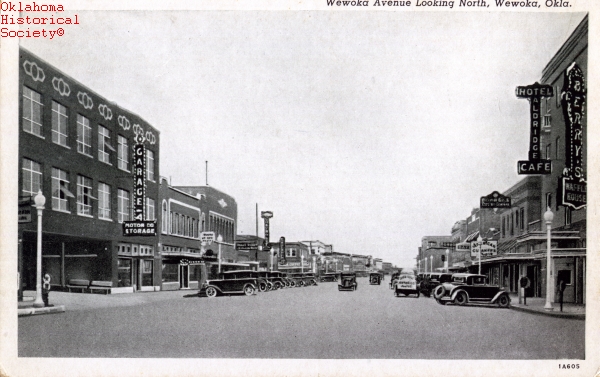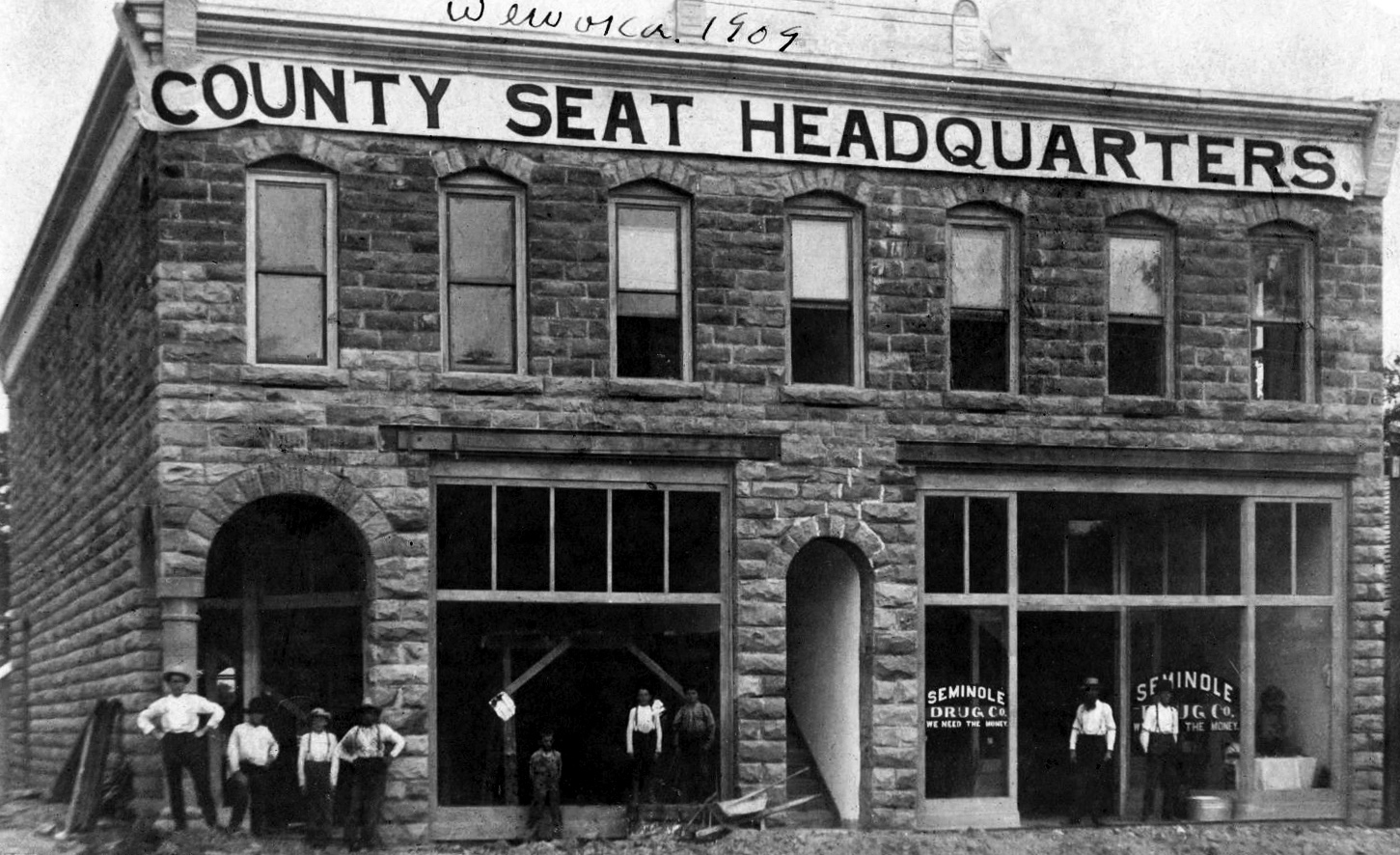
WEWOKA.
Located in east-central Seminole County, Wewoka is situated at the junction of State Highway 56 and U.S. Highway 270. Wewoka was originally located in the Seminole Nation, Indian Territory (I.T.). In 1849 Gopher John (a.k.a. John Horse) and other Seminole slaves located near present Wewoka. They continued to live independently of their Seminole owners, as they had before their removal from Florida. In 1866 after the Civil War Elijah J. Brown, a white trader, was selected by the government to lead Seminole refugees from Kansas to I.T. They settled near the site of Wewoka, and Brown established a trading post. He served as postmaster when the post office was established on May 13, 1867. Brown's trading post evolved into the Wewoka Trading Company, established in 1891. Around 1867 the federal government established a remount station nearby for soldiers traveling between Fort Gibson and Fort Sill. In 1866 Rev. James Ross Ramsey, a Presbyterian missionary, founded the Ramsey Mission (considered the first school in present Seminole County).
Wewoka, a Seminole word meaning "barking water," was the location of the Seminole national capital. In 1877 Seminole Gov. John F. Brown unified tribal factions and had a log house erected at Wewoka as the Seminole capitol. A pecan tree near the council house served as the Seminole "whipping tree" (listed in the National Register of Historic Places, NR 81000468). Seminole and African Americans who broke the law were suspended from the tree while being whipped.
In 1895 the Choctaw, Oklahoma and Gulf Railroad (after 1902 the Chicago, Rock Island and Pacific Railway) ran its line from McAlester to Oklahoma City, passing through Wewoka. Side tracks were installed, which caused consternation because shipments were sometimes lost on the side tracks. Thus, the saying "lost in the Wewoka Switch" originated in the early 1900s. The Wewoka Switch and Side Tracks (NR 85002475) were added to the National Register of Historic Places in 1985. The townsite was platted in 1897. The Seminole National Council decreed that the town lots were reserved for American Indians only. However, in 1902 settlement of the town was opened to white settlers. Early-day newspapers included the Wewoka Herald, the Wewoka Democrat, and the Seminole County Capital. By 1907 statehood the population stood at 794 and in 1910 at 1,022. Wewoka was selected as the county seat in a special election held in 1908. However, Seminole and Konawa townspeople contested the selection, and another election was held in 1920, with Wewoka again the victor. County offices were located in the Seminole National Capitol building until the Seminole County Courthouse (NR 84003429) was completed in 1927.
In March 1923 Roland H. Smith drilled Wewoka's first commercial oil well, the Betsy Foster Number One. A building boom soon followed in order to house oil-field workers and their families. The Hotel Aldridge (NR 86001083) was completed in the late 1920s. Lake Wewoka, northwest of town, was developed to serve as a water reservoir. By May 1928 an amusement park had been added for recreation near the lake. Junior college courses were offered at the high school beginning in 1929. The population peaked at 10,401 in 1930. In addition to the oil and gas industry, agriculture played a significant part in the local economy. Prominent crops included cotton, peaches, peanuts, pecans, and Silvermine variety of corn. Beef cattle and dairy cows were raised. During the post–World War II years Wewoka lost residents. In 1950 and 1960 the censuses reported 6,747 and 5,954, respectively.
Wewoka observed its centennial in June 1966. Ten years later the annual Sorghum Days event was begun. The Seminole Nation Museum opened in the fall 1974. Major employers have included the Wewoka Brick Company, the Wewoka Packing Plant, the Oklahoma Clothing Manufacturing Company (men's and boys' pants and blue jeans), Lillian Russell (dress manufacturing), Acker Industries (steel products), and Plasteck Central (aircraft parts). In 1980 Wewoka had 5,472 inhabitants. At the turn of the twenty-first century the community had 3,562 residents and a council/manager form of town government. The 2010 census reported a decline to 3,430 residents. In April 2020 the U.S. Census reported a population of 3,135. The weekly Wewoka Times kept citizens informed. The Jackson Brown House (NR 80003299), the Silas L. Brown House (NR 85001697), and the J. Coody Johnson Building (NR 85001744) were listed in the National Register of Historic Places. Prominent Oklahomans who have lived in Wewoka include civic and military leader William S. Key, attorney J. Coody Johnson, and Pulitzer Prize–winning journalist Vance Trimble.







